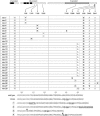A major determinant for membrane protein interaction localizes to the carboxy-terminal domain of the mouse coronavirus nucleocapsid protein
- PMID: 16227251
- PMCID: PMC1262602
- DOI: 10.1128/JVI.79.21.13285-13297.2005
A major determinant for membrane protein interaction localizes to the carboxy-terminal domain of the mouse coronavirus nucleocapsid protein
Abstract
The two major constituents of coronavirus virions are the membrane (M) and nucleocapsid (N) proteins. The M protein is anchored in the viral envelope by three transmembrane segments flanked by a short amino-terminal ectodomain and a large carboxy-terminal endodomain. The M endodomain interacts with the viral nucleocapsid, which consists of the positive-strand RNA genome helically encapsidated by N protein monomers. In previous work with the coronavirus mouse hepatitis virus (MHV), a highly defective M protein mutant, MDelta2, was constructed. This mutant contained a 2-amino-acid carboxy-terminal truncation of the M protein. Analysis of second-site revertants of MDelta2 revealed mutations in the carboxy-terminal region of the N protein that compensated for the defect in the M protein. To seek further genetic evidence corroborating this interaction, we generated a comprehensive set of clustered charged-to-alanine mutants in the carboxy-terminal domain 3 of N protein. One of these mutants, CCA4, had a highly defective phenotype similar to that of MDelta2. Transfer of the CCA4 mutation into a partially diploid MHV genome showed that CCA4 was a loss-of-function mutation rather than a dominant-negative mutation. Analysis of multiple second-site revertants of CCA4 revealed mutations in both the M protein and the N protein that could compensate for the original lesion in N. These data more precisely define the region of the N protein that interacts with the M protein. Further, we found that fusion of domain 3 of the N protein to the carboxy terminus of a heterologous protein caused it to be incorporated into MHV virions.
Figures







Similar articles
-
Coronavirus genomic RNA packaging.Virology. 2019 Nov;537:198-207. doi: 10.1016/j.virol.2019.08.031. Epub 2019 Aug 30. Virology. 2019. PMID: 31505321 Free PMC article. Review.
-
Genetic evidence for a structural interaction between the carboxy termini of the membrane and nucleocapsid proteins of mouse hepatitis virus.J Virol. 2002 May;76(10):4987-99. doi: 10.1128/jvi.76.10.4987-4999.2002. J Virol. 2002. PMID: 11967315 Free PMC article.
-
Analyses of Coronavirus Assembly Interactions with Interspecies Membrane and Nucleocapsid Protein Chimeras.J Virol. 2016 Apr 14;90(9):4357-4368. doi: 10.1128/JVI.03212-15. Print 2016 May. J Virol. 2016. PMID: 26889024 Free PMC article.
-
Identification of in vivo-interacting domains of the murine coronavirus nucleocapsid protein.J Virol. 2009 Jul;83(14):7221-34. doi: 10.1128/JVI.00440-09. Epub 2009 May 6. J Virol. 2009. PMID: 19420077 Free PMC article.
-
Nucleocapsid structure and function.Curr Top Microbiol Immunol. 2009;329:103-28. doi: 10.1007/978-3-540-70523-9_6. Curr Top Microbiol Immunol. 2009. PMID: 19198564 Review.
Cited by
-
Genetic and molecular biological analysis of protein-protein interactions in coronavirus assembly.Adv Exp Med Biol. 2006;581:163-73. doi: 10.1007/978-0-387-33012-9_29. Adv Exp Med Biol. 2006. PMID: 17037525 Free PMC article. Review. No abstract available.
-
Coronavirus genomic RNA packaging.Virology. 2019 Nov;537:198-207. doi: 10.1016/j.virol.2019.08.031. Epub 2019 Aug 30. Virology. 2019. PMID: 31505321 Free PMC article. Review.
-
Nucleocapsid mutations in SARS-CoV-2 augment replication and pathogenesis.PLoS Pathog. 2022 Jun 21;18(6):e1010627. doi: 10.1371/journal.ppat.1010627. eCollection 2022 Jun. PLoS Pathog. 2022. PMID: 35728038 Free PMC article.
-
Caspase-mediated cleavage of nucleocapsid protein of a protease-independent porcine epidemic diarrhea virus strain.Virus Res. 2020 Aug;285:198026. doi: 10.1016/j.virusres.2020.198026. Epub 2020 May 18. Virus Res. 2020. PMID: 32482590 Free PMC article.
-
Post-translational modifications of coronavirus proteins: roles and function.Future Virol. 2018 Jun;13(6):405-430. doi: 10.2217/fvl-2018-0008. Epub 2018 May 21. Future Virol. 2018. PMID: 32201497 Free PMC article. Review.
References
-
- Bogan, A. A., and K. S. Thorn. 1998. Anatomy of hot spots in protein interfaces. J. Mol. Biol. 280:1-9. - PubMed
Publication types
MeSH terms
Substances
Grants and funding
LinkOut - more resources
Full Text Sources

